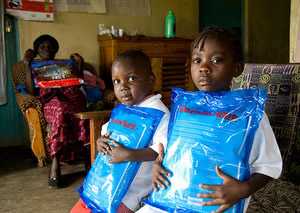Translating Research into Public Health Policy & Practice
The effectiveness of CDC Kenya’s work can be seen in the number and quality of evidence-based policies implemented by the Kenyan government and globally.
Supporting Evidence-based Policy

Orphans receive bed nets through the CDC Foundation. These children are among 140 cared for by a group of 25 local widows in the village of Aluor, Kenya, which has been hard-hit not only by the HIV pandemic but also by malaria. © David Synder
CDC Kenya’s integrated platform of activities eases the translation of public health research into policy recommendations for Government of Kenya officials.
Over twenty years ago, research conducted by CDC Kenya and its partners led to the development of national and international recommendations for the use of bed nets as an effective prevention intervention for malaria. More recently, research by CDC Kenya’s partners showed that voluntary medical male circumcision (VMMC) reduces the risk of female-to-male HIV transmission by approximately 60 percent. CDC has supported Kenya Ministry of Health officials in implementing VMMC guidelines resulting in more than 727,000 Kenyan adolescent and adult males receiving VMMC services from CDC Kenya partners from 2008-2014.
Similarly, as a result of a CDC and the Kenya Medical Research Institute (KEMRI) study that evaluated the use of zinc treatment for diarrhea in children, the Ministry of Health decided to introduce the use of zinc supplements for 10-14 days, along with an oral rehydration solution, for the management of diarrhea in children under five years of age who come to health facilities. Globally, diarrhea is the second leading cause of death in children under the age of five and a major area of research for CDC Kenya. As part of a three year case-control study of moderate-to-severe diarrhea in children under five, CDC and partners are examining why infants and children become severely ill with and die from diarrhea, which can be prevented. The hope is to put policies in place in the future to reduce preventable diarrhea-related deaths.
Contributing to Recommendations and Guidelines
A sustainable public health system infrastructure and comprehensive disease surveillance systems are critical to the timely development and implementation of policies and strategies that achieve maximum health impact. CDC Kenya is working closely with the Division of Non-Communicable Diseases at the Ministry of Health to help develop a national non-communicable disease (NCD) action plan to guide the country in the prevention and control of NCDs and the allocation of resources to the highest priority NCD areas. In addition, CDC plans to support the development of a behavioral risk factor survey across Kenya to better understand what behaviors and lifestyle choices are leading to a greater risk of NCDs.
CDC Kenya’s research and evaluation activities have made significant contributions to global and regional public health policy. The CDC and KEMRI research platform was the only site in East Africa that was part of the multi-country ground-breaking study (HPTN052) that showed a 96 percent reduction in HIV transmission in discordant couples – a pair of long-term partners where one partner in HIV-position and the other is HIV-negative – when the HIV-positive partner is provided HIV treatment.
The findings of this research supported the World Health Organization’s 2013 revised antiretroviral therapy (ART) guidance that recommended providing ART to an HIV-positive partner in a discordant couple, regardless of the individual’s CD4 count. In 2014, the Kenya Ministry of Health issued their revised ART guidance, which included adopting the WHO recommendation for discordant couples. CDC Kenya is now helping contribute to the Ministry of Health’s guidance to expand HIV treatment as prevention activities nationwide.
- Page last reviewed: March 30, 2015
- Page last updated: March 30, 2015
- Content source:
Global Health
Notice: Linking to a non-federal site does not constitute an endorsement by HHS, CDC or any of its employees of the sponsors or the information and products presented on the site.


 ShareCompartir
ShareCompartir